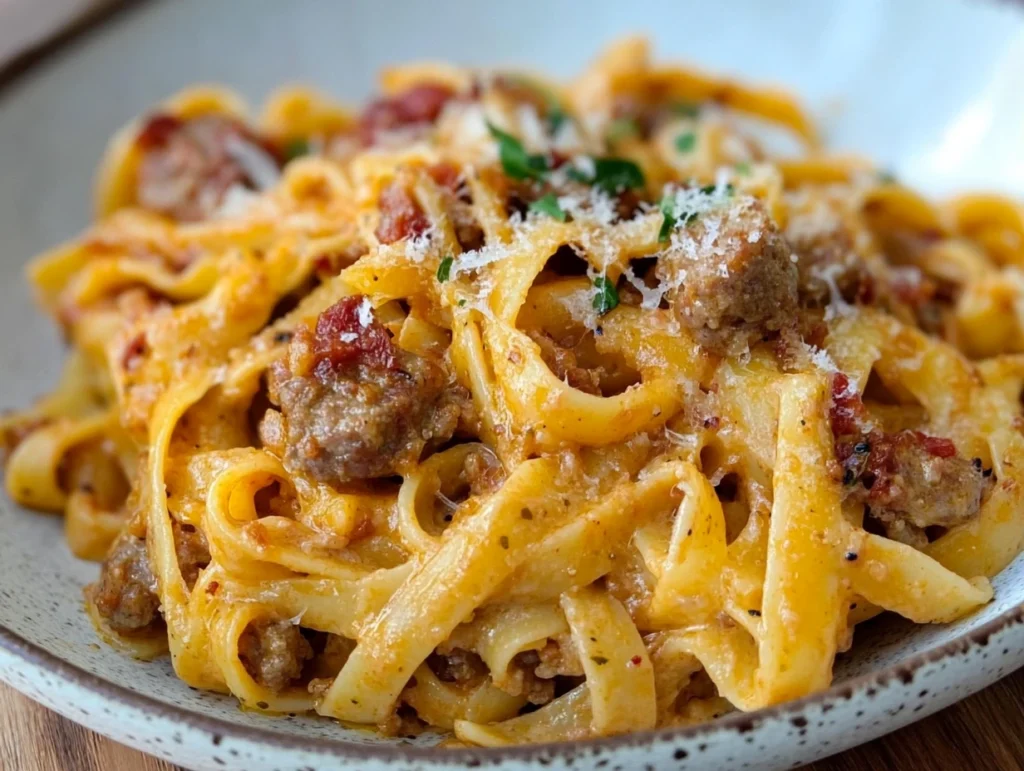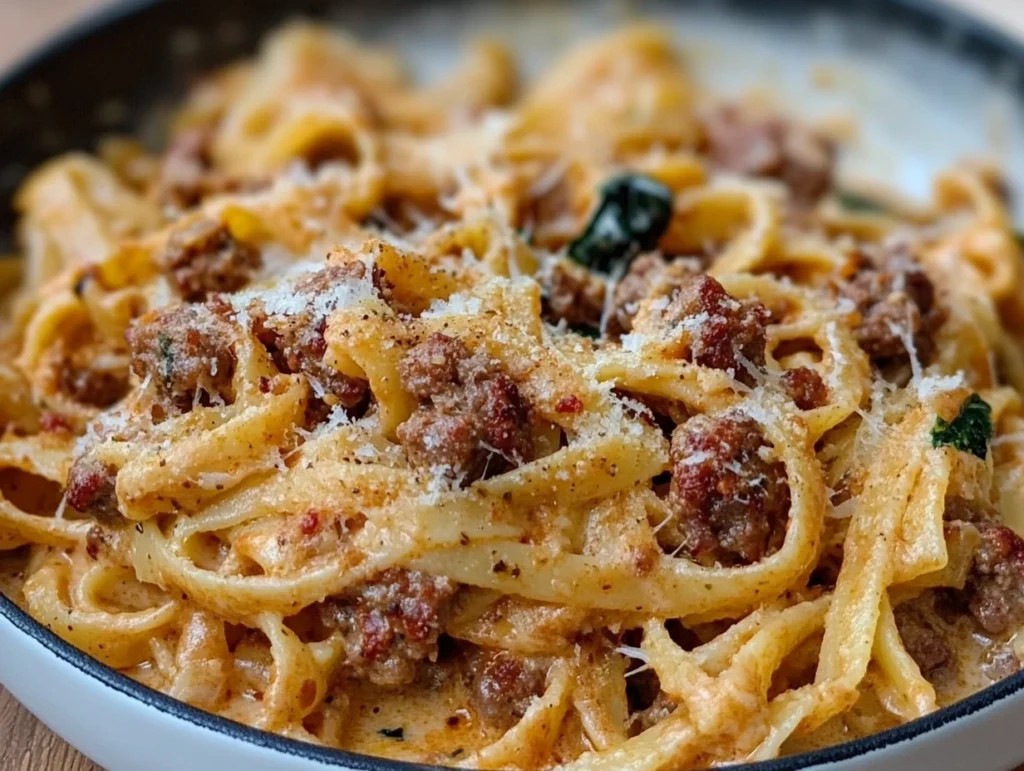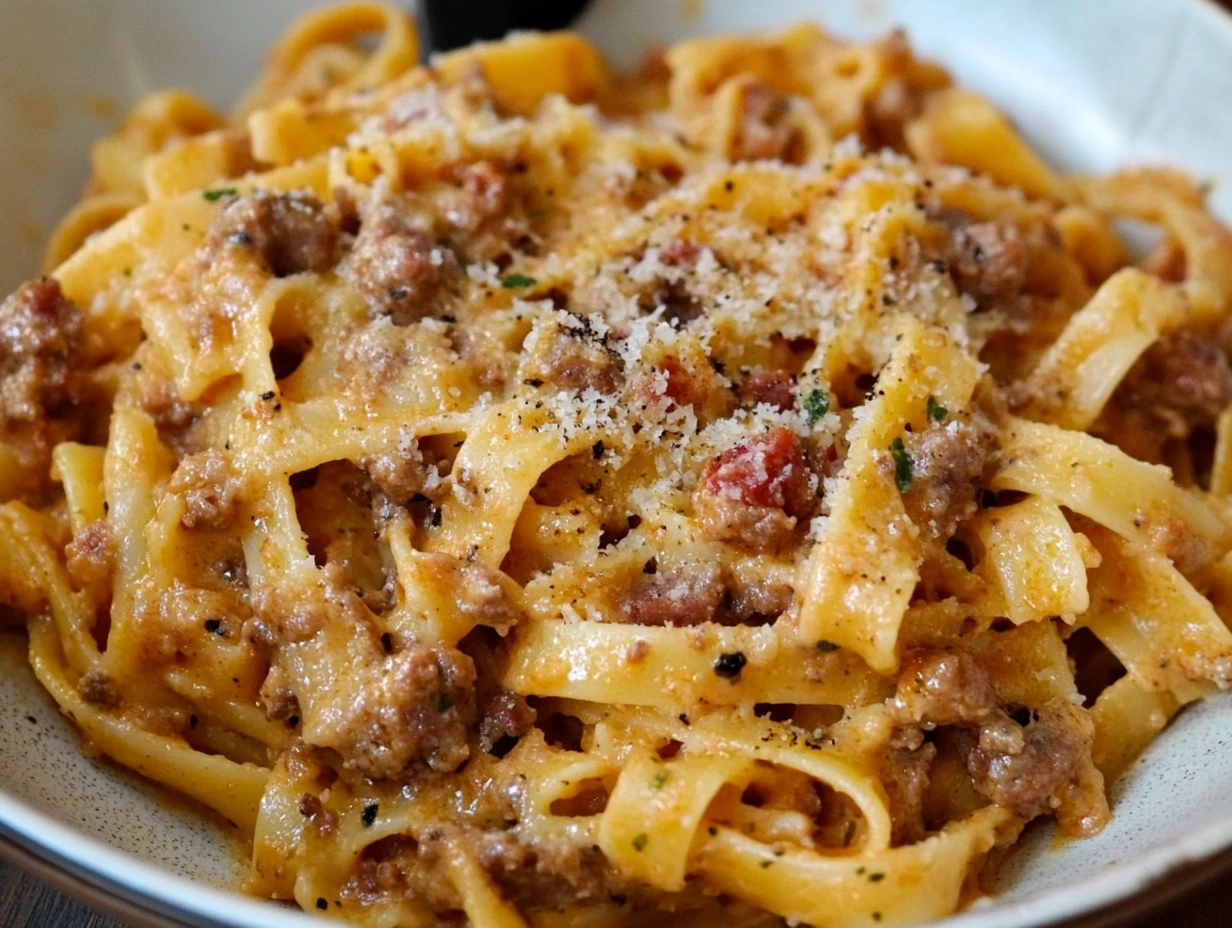Creamy Sausage Pasta recipe is a dish that strikes the perfect balance between hearty and indulgent. It combines rich, savory flavors with a velvety sauce and tender pasta, making it ideal for a cozy family dinner or a quick weeknight meal. With its warm and creamy texture, it’s a dish that feels like a hug in a bowl. Plus, it’s versatile, allowing you to customize it with your favorite ingredients while staying simple enough for beginners.

Table of Contents
Ingredients for Creamy Sausage Pasta
Choosing the Right Sausage
The type of sausage you choose can make or break the dish. For a rich and flavorful result:
- Italian Sausage (mild or spicy) adds a bold, seasoned kick.
- Smoked Sausage offers a deep, smoky flavor that pairs well with creamy sauces.
- Chicken or Turkey Sausage is a leaner option that still delivers great taste.
- For a vegetarian twist, opt for plant-based sausages with robust seasoning.
Best Pasta Types for the Dish
Not all pasta is created equal when it comes to holding creamy sauces. Choose:
- Penne: Its tube-like shape captures the sauce inside for every bite.
- Fettuccine: Wide, flat noodles work beautifully with creamy sauces.
- Rigatoni: Larger ridged tubes that grip the sauce and sausage perfectly.
- Fusilli: Twisted pasta that clings to every drop of the sauce.
- Avoid thin pasta like angel hair as it may get overwhelmed by the sauce’s richness.
Other Essential Ingredients
- Heavy Cream: The base of the sauce for that velvety consistency.
- Parmesan Cheese: Adds salty, nutty depth and helps thicken the sauce.
- Garlic: Fresh cloves are key for an aromatic, flavorful base.
- Onions: For sweetness and an additional layer of flavor.
- Crushed Tomatoes or Tomato Paste: Balances creaminess with a hint of acidity.
- Fresh Herbs: Basil, parsley, or thyme enhance the freshness.
- Red Pepper Flakes: A sprinkle for heat, optional but recommended for spicy lovers.
- Olive Oil or Butter: For sautéing the sausage and vegetables.
Step-by-Step Instructions for Creamy Sausage Pasta
Prepping the Sausage
- Choose Your Sausage: Use your favorite type (Italian, smoked, chicken, or turkey). Remove the casing if necessary.
- Slice or Crumble: For a chunky texture, slice the sausage into bite-sized pieces. For a more integrated dish, crumble the sausage into smaller bits.
- Cook Thoroughly: In a large skillet, heat a tablespoon of olive oil or butter over medium heat. Add the sausage and cook until browned and fully cooked (5-7 minutes). Set aside on a plate while leaving the rendered fat in the pan for extra flavor.
Cooking the Pasta Perfectly
- Boil the Water: Bring a large pot of salted water to a rolling boil. Use about 1 tablespoon of salt per 4 quarts of water.
- Cook the Pasta: Add your pasta (penne, rigatoni, or fettuccine) and cook it 1-2 minutes less than the package instructions for al dente texture.
- Reserve Pasta Water: Before draining, save about 1 cup of the starchy pasta water. This will help adjust the sauce’s consistency later.
- Drain and Toss: Drain the pasta and lightly toss it with a drizzle of olive oil to prevent sticking.
Combining Ingredients for a Creamy Sauce
- Sauté Aromatics: In the same skillet used for the sausage, add a bit more olive oil or butter if needed. Sauté minced garlic and chopped onions until fragrant and translucent (about 2-3 minutes).
- Deglaze the Pan: Add a splash of chicken broth or white wine to loosen any browned bits stuck to the pan—this adds extra flavor.
- Create the Sauce Base: Stir in heavy cream, crushed tomatoes (or tomato paste), and season with salt, pepper, and a pinch of red pepper flakes. Simmer for 5-7 minutes until the sauce thickens slightly.
- Incorporate Cheese: Lower the heat and stir in freshly grated Parmesan cheese. This will thicken the sauce and add depth.
- Combine with Pasta and Sausage: Add the cooked sausage and pasta to the skillet. Toss to coat everything evenly in the sauce. Use reserved pasta water as needed to adjust the sauce’s thickness.
Adding Vegetables for Extra Flavor
- Choose Your Veggies: Popular options include spinach, kale, mushrooms, bell peppers, or zucchini.
- Cook Them Separately: For the best texture, sauté the vegetables in olive oil until tender before adding them to the sauce. This prevents overcooking.
- Mix Them In: Gently fold the cooked vegetables into the pasta and sauce mixture just before serving.

Tips for Enhancing Flavor in Creamy Sausage Pasta
Spices and Herbs to Use
- Fresh Herbs: Basil, parsley, and thyme bring freshness and brighten the dish. Chop and sprinkle them over the finished pasta for a fragrant finish.
- Spices for Depth: A pinch of smoked paprika or nutmeg adds subtle warmth to the creamy sauce.
- Red Pepper Flakes: For a hint of spice, sprinkle some flakes while sautéing the sausage.
- Italian Seasoning Blend: A mix of oregano, rosemary, and marjoram enhances the classic Italian flavors.
- Garlic and Onion Powder: If you want a bolder garlic and onion profile, add powdered versions along with the fresh ingredients.
Cream Substitutes for a Lighter Option
- Half-and-Half: A mix of milk and cream provides a lighter yet creamy texture.
- Greek Yogurt: Adds creaminess with a tangy twist while cutting down on fat.
- Coconut Milk: For a dairy-free option with a slight sweetness.
- Almond Milk or Oat Milk: Combine with a cornstarch slurry to mimic the thickness of cream.
- Cream Cheese: Use a reduced-fat version for a creamy but lighter alternative.
Cooking Techniques for Richness
- Use Pasta Water: The starchy water from boiling pasta enhances the sauce’s texture and binds it to the noodles.
- Sear the Sausage: Browning the sausage caramelizes the natural sugars, adding a deep, savory flavor to the dish.
- Layer Flavors: Add ingredients gradually. For example, sauté garlic and onions first, then add cream and seasonings to build complexity.
- Simmer Slowly: Allow the sauce to simmer gently to develop richness without breaking the cream.
- Add Cheese Gradually: Stir in Parmesan cheese slowly over low heat to avoid clumping and ensure a smooth sauce.
Variations of Creamy Sausage Pasta
Gluten-Free Option
- Gluten-Free Pasta: Use pasta made from rice, quinoa, or chickpeas. Cook carefully to avoid overcooking.
- Thickeners: Ensure any additional thickeners, like cornstarch, are gluten-free.
- Check Sausage Ingredients: Some sausages contain fillers with gluten—opt for certified gluten-free sausages.
Vegan Adaptation
- Vegan Sausage: Use plant-based sausage made from tofu, tempeh, or jackfruit.
- Non-Dairy Cream Alternatives: Use coconut cream, cashew cream, or unsweetened almond milk thickened with cornstarch.
- Vegan Cheese: Substitute Parmesan with nutritional yeast or plant-based cheese shreds.
- Olive Oil Base: Instead of butter, use olive oil to sauté the aromatics and create the base of the sauce.
Low-Carb Sausage Pasta Recipe
- Zucchini Noodles or Spaghetti Squash: Replace traditional pasta with spiralized zucchini or cooked spaghetti squash for a low-carb twist.
- Keto-Friendly Sausage: Opt for sausages without added sugars or fillers.
- Heavy Cream and Cheese: Stick to full-fat options like heavy cream and Parmesan, which are naturally low in carbs.
- Cauliflower Cream Sauce: Blend cooked cauliflower with a bit of broth and cheese for a creamy, low-carb alternative.
Pairing Suggestions for Creamy Sausage Pasta
Side Dishes
- Garlic Bread: A classic pairing that’s perfect for soaking up the creamy sauce. Use crusty bread with a buttery, garlicky spread.
- Simple Salad: A fresh green salad with a light vinaigrette balances the richness of the pasta. Add arugula, spinach, or mixed greens with cherry tomatoes and cucumbers.
- Roasted Vegetables: Roasted asparagus, broccoli, or Brussels sprouts add a caramelized, slightly crunchy texture.
- Caprese Salad: Fresh mozzarella, tomatoes, and basil drizzled with balsamic glaze complement the creamy and savory notes of the pasta.
- Soup Starter: A light vegetable or tomato-based soup makes for a cozy pairing before the main dish.
Wine Pairings
- White Wine: A crisp Chardonnay or Pinot Grigio pairs beautifully with the creaminess of the sauce.
- Red Wine: Light-bodied reds like Pinot Noir or Chianti enhance the sausage’s savory flavors without overpowering the dish.
- Sparkling Wine: A glass of Prosecco adds a refreshing contrast to the rich pasta.
- Non-Alcoholic Options: Try sparkling water with lemon or a fruity iced tea for a lighter, refreshing beverage.

Common Mistakes to Avoid
When Cooking the Pasta
- Under-Seasoning the Water: Always salt your pasta water generously; it’s your only chance to season the pasta itself.
- Overcooking the Pasta: Cook the pasta until just al dente, as it will continue to cook when mixed with the sauce.
- Not Reserving Pasta Water: Skipping this step can leave you without an easy way to adjust the sauce’s consistency.
When Preparing the Sauce
- Breaking the Cream: Adding cream to a very hot pan or boiling it too rapidly can cause it to curdle. Simmer gently on low heat instead.
- Adding Cheese Too Quickly: Parmesan or other cheeses should be stirred in slowly over low heat to prevent clumping.
- Neglecting the Aromatics: Failing to sauté onions and garlic thoroughly can result in a flat-tasting sauce. Always let them cook until fragrant.
Ingredient Choices
- Choosing the Wrong Pasta: Avoid thin pasta like angel hair, as it can become mushy and won’t hold the sauce well.
- Using Low-Quality Sausage: Bland or poorly seasoned sausage will result in a less flavorful dish. Opt for high-quality, well-seasoned sausage.
Final Touches
- Skipping Fresh Herbs: Fresh parsley, basil, or thyme add brightness and elevate the dish. Don’t miss this final garnish!
- Overloading with Vegetables: While vegetables are a great addition, too many can dilute the flavors of the sauce and sausage.
FAQs About Creamy Sausage Pasta
Can I Use Any Sausage for This Recipe?
Yes, most types of sausage work well for this dish! Popular choices include:
- Italian Sausage: Mild or spicy, depending on your flavor preference.
- Smoked Sausage: Adds a deep, smoky taste.
- Chicken or Turkey Sausage: A leaner option with great flavor.
- Vegan Sausage: Plant-based options are perfect for a meat-free version.
Just make sure the sausage is well-seasoned to enhance the dish’s overall flavor.
What’s the Best Way to Reheat Creamy Sausage Pasta?
To keep the pasta creamy while reheating:
- Stovetop: Heat gently in a skillet over low heat, adding a splash of milk, cream, or reserved pasta water to loosen the sauce.
- Microwave: Use medium heat and stir every 30 seconds, adding a little liquid if the sauce looks dry.
Avoid overheating, as this can cause the sauce to separate.
How Can I Make It Dairy-Free?
Replace dairy ingredients with these alternatives:
- Heavy Cream: Use coconut cream, cashew cream, or unsweetened almond milk thickened with cornstarch.
- Parmesan Cheese: Swap it for nutritional yeast or plant-based cheese shreds.
- Butter: Replace with olive oil or vegan butter.
Make sure your sausage is dairy-free as well, as some varieties contain milk-based fillers.
Can I Prepare the Sauce in Advance?
Yes, you can make the sauce ahead of time:
- Cook the sausage, sauté the aromatics, and prepare the creamy sauce.
- Store it in an airtight container in the refrigerator for up to 3 days.
- When ready to serve, reheat the sauce gently and toss it with freshly cooked pasta.
Should I Rinse the Pasta After Boiling?
No, do not rinse the pasta. Rinsing removes the starchy coating that helps the sauce stick to the pasta. Instead:
- Drain the pasta and toss it immediately with the sauce.
- Reserve some pasta water to adjust the sauce’s consistency if needed.
How Do I Store Leftovers?
- Refrigerator: Store leftovers in an airtight container for up to 3 days.
- Freezer: Freeze for up to 2 months, but note that cream-based sauces may separate slightly when thawed.
- Reheat: Always reheat gently with a splash of liquid to maintain creaminess.
Additional Questions
What Type of Pasta Is Best for Creamy Pasta?
The best pasta for creamy dishes has shapes that hold sauce well, such as:
- Penne or Rigatoni: Tubular shapes capture the sauce inside.
- Fusilli or Rotini: Twisted shapes cling to the sauce.
- Fettuccine or Tagliatelle: Wide, flat noodles work perfectly with creamy sauces.
What Sauce Goes Well with Sausage?
Besides creamy sauces, these options pair beautifully with sausage:
- Marinara Sauce: A classic tomato-based sauce for a lighter dish.
- Vodka Sauce: Combines tomato, cream, and vodka for a silky, tangy flavor.
- Pesto: A fresh, herby sauce that complements sausage nicely.
- Cheese Sauce: A rich, cheesy béchamel works wonderfully with sausage.
How Do You Keep Creamy Pasta Creamy?
- Add Pasta Water: The starchy water helps maintain the sauce’s texture.
- Simmer Slowly: Avoid high heat, as it can break the sauce.
- Stir Continuously: To prevent separation, stir frequently while cooking.
- Add Cheese Gradually: Stir it in slowly over low heat for a smooth consistency.
How to Jazz Up Boring Pasta?
- Upgrade the Sauce: Add fresh herbs, spices, or a splash of wine to enhance flavor.
- Add Texture: Top with toasted breadcrumbs, crispy pancetta, or nuts.
- Incorporate Vegetables: Sautéed spinach, mushrooms, or roasted cherry tomatoes can liven up the dish.
- Use High-Quality Cheese: Freshly grated Parmesan, Pecorino Romano, or a dollop of ricotta can elevate your pasta.
- Experiment with Toppings: A drizzle of truffle oil or a sprinkle of chili flakes adds a gourmet touch.
If you’re a fan of hearty, comforting meals, our Creamy Sausage Pasta recipe pairs beautifully with side dishes like the Air Fryer Red Potatoes Recipe, a crispy and flavorful complement to the creamy sauce. For a touch of freshness, consider serving it alongside a vibrant salad inspired by the Grilled Salmon Salad recipe, or add extra flair by including Fried Zucchini for a crunchy veggie side. Additionally, those who love cheesy, comforting meals might enjoy exploring our Cheesy Green Bean Casserole Recipe, which offers another indulgent option perfect for gatherings or weeknight dinners.
Conclusion:
Creamy Sausage Pasta is the ultimate comfort dish, combining rich flavors, a velvety sauce, and hearty sausage for a meal that feels like a warm embrace. Whether you’re preparing it for a weeknight dinner, a family gathering, or simply to satisfy a craving, this recipe is sure to become a go-to favorite. With endless opportunities to customize, from adding vegetables to trying out lighter or dairy-free options, it’s as versatile as it is delicious. Pair it with complementary sides or a glass of wine to elevate the experience. Now that you have all the tips and tricks for perfecting this dish, it’s time to bring the flavors to life in your kitchen and enjoy every creamy, savory bite. Happy cooking!

